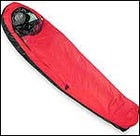Back in the day, backpackers and mountaineers used to head into the hills with a chunk of sail cloth in their packs. When it came time to bed down, they’d wrap up in that cloth like a moth in a cocoon, waiting out whatever storms blew over.
 Minimalist Bivy
Minimalist Bivy
These days we have better choices. One of them is: Nothing. As in, don’t pack anything that resembles a “shelter.” Yvon Chouinard, founder of Patagonia, rarely carried a tent when he went climbing during his heyday. He’d find a cave to curl up in, or a tree with a good, tight bough structure. If a few drips came through, no harm. And that isn’t a bad model to follow. There are lots of places in the West where there’s sufficient natural shelter so that you don’t really need to take anything extra.
For a really low-budget, minimalist shelter, just go to your local hardware store and purchase an inexpensive five- by seven-foot blue poly tarp鈥攗sually just $5 or so. Completely waterproof, and you can use the grommets to make a little lean-to. Otherwise, a good choice is a simple bivouac bag. And I emphasize “simple,” because some bivy bags have become miniature tents. You just want a waterproof bag with a hood, such as REI’s Minimalist Bivy ($89, www.rei.com), which uses a proprietary laminate material to create a nice, light bag that’s weatherproof but weighs just over one pound. An even lighter bivy bag is Mont-Bell’s U.L Sleeping Bag Cover ($160, www.montbell.com), which uses two-ply Gore-Tex and weighs in at a mere seven ounces. An excellent choice for occasional use.
Then you have lightweight tarps. You pay a marginal price here for a few extra widgets like poles and stakes to set things up, but you’ll generally get better coverage. GoLite makes a range of featherlight shelters that’ll hardly burden your progress, including the aesthetic Lair 1 ($100, www.golite.com). Of course, your final decision may hinge on the environment in which you’re camping. The Wasatch range in July, no problem. Virginia’s soggy Shenandoah front same time of year? Think humidity and bugs, for which it’s worth paying the relative weight penalty of a tent to combat sudden storms and blood-sucking nasties.


